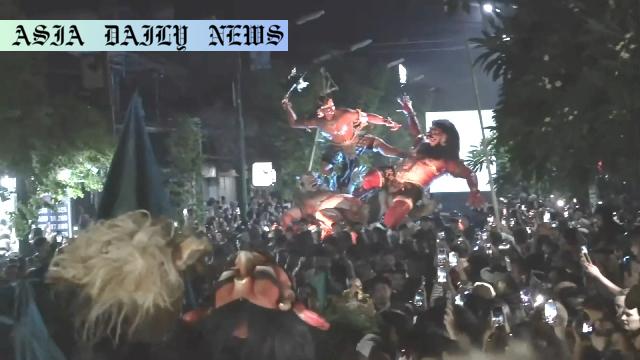Ogoh-Ogoh effigies are burned after the parade, symbolizing the removal of evil spirits and the ushering in of peace and prosperity for the Hindu New Year.
The Ogoh-Ogoh parade in Bali celebrates Hindu New Year’s Eve.
Large monster effigies symbolize demons and evil spirits.
Effigies are burnt to signify purification and usher in peace.
The community takes pride in showcasing their artistic creations during the event.

The Majestic Ogoh-Ogoh Parade: A Unique Tradition in Bali
The Ogoh-Ogoh parade, a significant cultural event in Bali, marks Hindu New Year’s Eve with grandeur and spiritual fervor. The event is centered around lavishly crafted effigies of monstrous figures known as ‘Ogoh-Ogoh,’ which represent demons, malevolent spirits, and negative energies. These effigies are intricately designed by local communities, each vying to outdo the other in creativity and craftsmanship. Constructed from bamboo, paper, and other materials, the figures stand tall and imposing, often resembling fantastical beasts or mythological creatures with exaggerated features to appear as frightening as possible.
The parade, which attracts both locals and tourists, begins in the evening and extends into the night. Crowds gather along the streets as groups of young men carry the Ogoh-Ogoh on large bamboo frames. Accompanied by traditional gamelan music, the carriers vigorously shake the effigies to create an animated and lively scene, portraying the fierce battle between good and evil. This spectacle is designed to frighten away negative spirits and symbolically purify the environment for the coming year. For many, it is not only a communal festivity but also a deeply personal act of spiritual renewal.
Burning the Ogoh-Ogoh: A Symbol of Renewal
The culmination of the Ogoh-Ogoh parade is the ritual burning of the effigies. After being paraded through the streets, the figures are ceremoniously set aflame. This act signifies the destruction of evil and the clearing away of negative energies. As the fire consumes the effigies, it is believed to pave the way for peace, prosperity, and tranquility in the new year. For participants and onlookers alike, this moment holds deep symbolic significance. A female resident of Bali expressed her hope for peace and purification following the event, echoing a sentiment shared by many in attendance.
Beyond its religious and spiritual aspects, the Ogoh-Ogoh parade has become a source of cultural pride for the Balinese people. The effort that goes into crafting these effigies, particularly by the younger generation, underscores the importance of preserving traditions and passing them down through the years. It also fosters a sense of unity and collaboration within communities, as everyone works together to bring the event to life.
The Broader Significance of the Ogoh-Ogoh Parade
The Ogoh-Ogoh parade is more than just a local festivity; it is a vibrant display of Bali’s rich cultural heritage and spiritual depth. While it is rooted in Hindu religious beliefs, the event has evolved into an inclusive celebration that welcomes people of all backgrounds. Tourists who witness the parade often leave with a newfound appreciation for Balinese culture and its unique way of intertwining art, spirituality, and community.
For Bali, the parade also serves as an opportunity to showcase its cultural identity on the global stage. It highlights the island’s ability to preserve age-old traditions while adapting to the modern world. In an era where traditional practices are increasingly under threat from globalization, the Ogoh-Ogoh parade stands as a testament to the resilience and vibrancy of Balinese culture. Through this annual event, the people of Bali reaffirm their commitment to balance and harmony, not just within themselves but also within their community and the natural world.
Commentary
Ogoh-Ogoh: A Celebration of Spirit and Culture
The Ogoh-Ogoh parade in Bali is a remarkable fusion of artistic expression, cultural heritage, and spiritual practice. Every year, this event captivates locals and tourists alike with its vivid depictions of demons and evil spirits. What resonates most about this celebration is how it embodies the Balinese philosophy of harmony – between humanity, the divine, and nature. The carefully crafted Ogoh-Ogoh effigies are not merely artistic marvels; they serve as powerful symbols of the eternal battle between good and evil, a theme that transcends cultural boundaries and finds relevance in every corner of the globe.
The Power of Community Spirit
One of the most inspiring aspects of this event is the collective effort and enthusiasm of the participants. Crafting the Ogoh-Ogoh effigies requires weeks, if not months, of meticulous planning and collaboration. Every detail, from the selection of materials to the final touches of paint, reflects the dedication and pride of the craftsmen. What strikes me most is how this tradition unites people, especially the younger generation, in a shared sense of purpose and identity. In an era where many societies are losing touch with their cultural roots, the Ogoh-Ogoh parade serves as a shining example of how traditions can be preserved and celebrated.
A Lesson for All
As the effigies are engulfed in flames at the end of the parade, one cannot help but reflect on the deeper meaning of this ritual. The burning signifies the release of negative energies, encouraging people to let go of past grievances and embrace a fresh start. It is a lesson in renewal and purification that holds universal relevance. Whether one views the parade as a religious rite, a cultural spectacle, or simply a unique tradition, it leaves a lasting impact on all who experience it. The Ogoh-Ogoh parade reminds us of the enduring power of community, tradition, and the human spirit to triumph over adversity.


